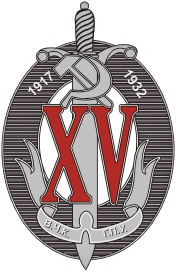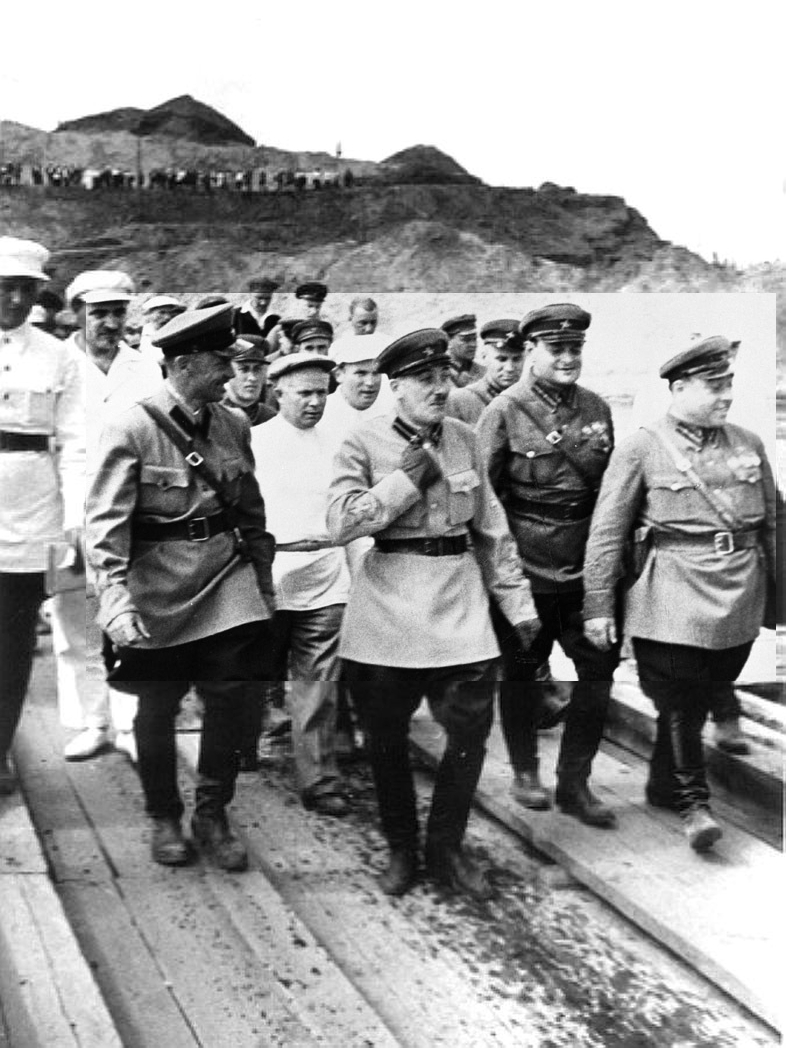|
OGPU
The Joint State Political Directorate (OGPU; russian: ą×ą▒čŖąĄą┤ąĖąĮčæąĮąĮąŠąĄ ą│ąŠčüčāą┤ą░čĆčüčéą▓ąĄąĮąĮąŠąĄ ą┐ąŠą╗ąĖčéąĖč湥čüą║ąŠąĄ čāą┐čĆą░ą▓ą╗ąĄąĮąĖąĄ) was the intelligence and state security service and secret police of the Soviet Union from 1923 to 1934. The OGPU was formed from the State Political Directorate of the Russian Soviet Federative Socialist Republic one year after the founding of the Soviet Union and responsible to the Council of People's Commissars. The agency operated inside and outside the Soviet Union, persecuting political criminals and opponents of the Bolsheviks such as White ├®migr├®s, Soviet dissidents, and anti-communists. The OGPU was based in the Lubyanka Building in Moscow and headed by Felix Dzerzhinsky until his death in 1926 and then Vyacheslav Menzhinsky until it was reincorporated as the Main Directorate of State Security (GUGB) of the NKVD in 1934. History Founding Following the formation of the Soviet Union in December 1922, the ... [...More Info...] [...Related Items...] OR: [Wikipedia] [Google] [Baidu] |
Felix Dzerzhinsky
Felix Edmundovich Dzerzhinsky ( pl, Feliks Dzier┼╝y┼äski ; russian: ążąĄ╠üą╗ąĖą║čü ąŁą┤ą╝čā╠üąĮą┤ąŠą▓ąĖčć ąöąĘąĄčƹȹĖ╠üąĮčüą║ąĖą╣; ŌĆō 20 July 1926), nicknamed "Iron Felix", was a Bolshevik revolutionary and official, born into Polish nobility. From 1917 until his death in 1926, Dzerzhinsky led the first two Soviet state-security organizations, the Cheka and the OGPU, establishing a secret police for the post-revolutionary Soviet regime. He was one of the architects of the Red Terror and decossackization. Early life Felix Dzerzhinsky was born on 11 September 1877 to ethnically Polish parents of noble descent, at the Dzerzhinovo family estate, about from the small town of Ivyanets in the Minsk Governorate of the Russian Empire (now Belarus). In the Russian Empire, his family was of a type known as " column-listed nobility" (russian: čüč鹊ą╗ą▒ąŠą▓ąŠąĄ ą┤ą▓ąŠčĆčÅąĮčüčéą▓ąŠ, stolbovoe dvorianstvo),Igor Kuznetsov. The Chekist No.1. The life of terror parent (ą¦ąĄą║ąĖčüčé ... [...More Info...] [...Related Items...] OR: [Wikipedia] [Google] [Baidu] |
NKVD Emblem (Gradient)
The People's Commissariat for Internal Affairs (russian: ąØą░čĆąŠ╠üą┤ąĮčŗą╣ ą║ąŠą╝ąĖčüčüą░čĆąĖą░╠üčé ą▓ąĮčā╠üčéčĆąĄąĮąĮąĖčģ ą┤ąĄą╗, Nar├│dnyy komissari├Īt vn├║trennikh del, ), abbreviated NKVD ( ), was the interior ministry of the Soviet Union. Established in 1917 as NKVD of the Russian Soviet Federative Socialist Republic, the agency was originally tasked with conducting regular police work and overseeing the country's prisons and labor camps. It was disbanded in 1930, with its functions being dispersed among other agencies, only to be reinstated as an all-union commissariat in 1934. The functions of the OGPU (the secret police organization) were transferred to the NKVD around the year 1930, giving it a monopoly over law enforcement activities that lasted until the end of World War II. During this period, the NKVD included both ordinary public order activities, and secret police activities. The NKVD is known for its role in political repression and for carrying out the Great ... [...More Info...] [...Related Items...] OR: [Wikipedia] [Google] [Baidu] |
NKVD
The People's Commissariat for Internal Affairs (russian: ąØą░čĆąŠ╠üą┤ąĮčŗą╣ ą║ąŠą╝ąĖčüčüą░čĆąĖą░╠üčé ą▓ąĮčā╠üčéčĆąĄąĮąĮąĖčģ ą┤ąĄą╗, Nar├│dnyy komissari├Īt vn├║trennikh del, ), abbreviated NKVD ( ), was the interior ministry of the Soviet Union. Established in 1917 as NKVD of the Russian Soviet Federative Socialist Republic, the agency was originally tasked with conducting regular police work and overseeing the country's prisons and labor camps. It was disbanded in 1930, with its functions being dispersed among other agencies, only to be reinstated as an all-union commissariat in 1934. The functions of the OGPU (the secret police organization) were transferred to the NKVD around the year 1930, giving it a monopoly over law enforcement activities that lasted until the end of World War II. During this period, the NKVD included both ordinary public order activities, and secret police activities. The NKVD is known for its role in political repression and for carrying out the Great ... [...More Info...] [...Related Items...] OR: [Wikipedia] [Google] [Baidu] |
Vyacheslav Menzhinsky
Vyacheslav Rudolfovich Menzhinsky (russian: ąÆčÅč湥čüą╗ą░╠üą▓ ąĀčāą┤ąŠ╠üą╗čīč乊ą▓ąĖčć ą£ąĄąĮąČąĖ╠üąĮčüą║ąĖą╣, pl, Wies┼éaw M─Ö┼╝y┼äski; 19 August 1874 ŌĆō 10 May 1934) was a Polish-Russian Bolshevik revolutionary, Soviet statesman and Communist Party official who served as chairman of the OGPU from 1926 to 1934. He was master of more than 10 languages (including Korean, Chinese, Turkish, and Persian, the last one learned especially in order to read works by Omar Khayy├Īm). Early life Vyacheslav Menzhinsky, a member of the Polish nobility, was born into an Orthodox Christian Polish-Russian family of teachers. His father was a Russified Pole and a history lecturer. His mother was a woman of letters who sympathised with the revolutionaries. His brother was a tsarist official, working for the Ministry of Finance. He graduated from the Faculty of Law at Saint Petersburg University in 1898, and practised law in Yaroslavl, while dabbling literature. He had a novel published in ... [...More Info...] [...Related Items...] OR: [Wikipedia] [Google] [Baidu] |
Main Directorate Of State Security
The Main Directorate of State Security (russian: Glavnoe upravlenie gosudarstvennoy bezopasnosti, ąōą╗ą░ą▓ąĮąŠąĄ čāą┐čĆą░ą▓ą╗ąĄąĮąĖąĄ ą│ąŠčüčāą┤ą░čĆčüčéą▓ąĄąĮąĮąŠą╣ ą▒ąĄąĘąŠą┐ą░čüąĮąŠčüčéąĖ, ąōąŻąōąæ, GUGB) was the name of the Soviet The Soviet Union,. officially the Union of Soviet Socialist Republics. (USSR),. was a List of former transcontinental countries#Since 1700, transcontinental country that spanned much of Eurasia from 1922 to 1991. A flagship communist state, ... most important security body within the People's Commissariat of Internal Affairs (NKVD) USSR. At the time of its existence, which was from July 10, 1934 to February 3, 1941, the GUGB reflected exactly the Secret Operational Directorate within OGPU under Council of People's Commissars, which operated within OGPU structure from 1923 to 1931/32. An intelligence service and secret police from July 1934 to February 1941, it was run under the auspices of the Peoples Commissariat of Internal Affairs (NKVD) ... [...More Info...] [...Related Items...] OR: [Wikipedia] [Google] [Baidu] |
Treaty On The Creation Of The Union Of Soviet Socialist Republics
hy, įĮšŹšĆšä š▒šźųéšĪšŠšĖųĆš┤šĪšČ š┤šĪšĮš½šČ š║šĪšĄš┤šĪšČšĪšŻš½ųĆ az, SSR─░-nin formala┼¤mas─▒ haqq─▒nda m├╝qavil╔Ö ka, ßā«ßāößāÜßā©ßāößāÖßāĀßāŻßāÜßāößāæßāÉ ßāĪßāĪßāĀßāÖ-ßāĪ ßāżßāØßāĀßāøßāśßāĀßāößāæßāśßāĪ ßā©ßāößāĪßāÉßā«ßāößāæ , image = Cover of the 1922 Declaration and Treaty on the Formation of the USSR.jpg , image_width = 234px , caption = , type = Union treaty , date_drafted = , date_signed = 29 December 1922 , location_signed = Moscow, Soviet Russia , date_sealed = , date_effective = 30 December 1922 , condition_effective = , date_expiration = 8 December 199121 December 199126 December 1991 , signatories = * Mikhail Frunze * Mikhail Kalinin * Grigory Petrovsky * Aleksandr Chervyakov * Mikhail Tskhakaya , parties = * * * * , depositor = , languages = Russian , website = , wikisource = The Declara ... [...More Info...] [...Related Items...] OR: [Wikipedia] [Google] [Baidu] |
State Political Directorate
The State Political Directorate (also translated as the State Political Administration) (GPU) was the intelligence service and secret police of the Russian Soviet Federative Socialist Republic (RSFSR) from February 6, 1922, to December 29, 1922, and the Soviet Union from December 29, 1922, until November 15, 1923. Name The official designation in line to the native reference is: *ąĀčāčüčüą║ąĖą╣: = ąōąŠčüčāą┤ą░čĆčüčéą▓ąĄąĮąĮąŠąĄ ą┐ąŠą╗ąĖčéąĖč湥čüą║ąŠąĄ čāą┐čĆą░ą▓ą╗ąĄąĮąĖąĄ (ąōą¤ąŻ) ą┐čĆąĖ ąØą░čĆąŠą┤ąĮąŠą╝ ą║ąŠą╝ąĖčüčüą░čĆąĖač鹥 ą▓ąĮčāčéčĆąĄąĮąĮąĖčģ ą┤ąĄą╗ (ąØąÜąÆąö) ąĀąĪążąĪąĀ * tr =Gosudarstvennoe politicheskoe upravlenie (GPU) pri narodnom komissariate vnutrennikh del (NKVD) RSFSR ŌĆō (GPU pri NKVD RSFSR) *English: = State Political Directorate (also State Political Administration) under the People's Commissariat of interior affairs of the Russian Soviet Federative Socialist Republic (RFSR) Establishment Formed from the Cheka, the original Russian state security organizatio ... [...More Info...] [...Related Items...] OR: [Wikipedia] [Google] [Baidu] |
Soviet Union
The Soviet Union,. officially the Union of Soviet Socialist Republics. (USSR),. was a List of former transcontinental countries#Since 1700, transcontinental country that spanned much of Eurasia from 1922 to 1991. A flagship communist state, it was nominally a Federation, federal union of Republics of the Soviet Union, fifteen national republics; in practice, both Government of the Soviet Union, its government and Economy of the Soviet Union, its economy were highly Soviet-type economic planning, centralized until its final years. It was a one-party state governed by the Communist Party of the Soviet Union, with the city of Moscow serving as its capital as well as that of its largest and most populous republic: the Russian Soviet Federative Socialist Republic, Russian SFSR. Other major cities included Saint Petersburg, Leningrad (Russian SFSR), Kyiv, Kiev (Ukrainian Soviet Socialist Republic, Ukrainian SSR), Minsk (Byelorussian Soviet Socialist Republic, Byelorussian SSR), Tas ... [...More Info...] [...Related Items...] OR: [Wikipedia] [Google] [Baidu] |
USSR
The Soviet Union,. officially the Union of Soviet Socialist Republics. (USSR),. was a transcontinental country that spanned much of Eurasia from 1922 to 1991. A flagship communist state, it was nominally a federal union of fifteen national republics; in practice, both its government and its economy were highly centralized until its final years. It was a one-party state governed by the Communist Party of the Soviet Union, with the city of Moscow serving as its capital as well as that of its largest and most populous republic: the Russian SFSR. Other major cities included Leningrad (Russian SFSR), Kiev ( Ukrainian SSR), Minsk ( Byelorussian SSR), Tashkent (Uzbek SSR), Alma-Ata (Kazakh SSR), and Novosibirsk (Russian SFSR). It was the largest country in the world, covering over and spanning eleven time zones. The country's roots lay in the October Revolution of 1917, when the Bolsheviks, under the leadership of Vladimir Lenin, overthrew the Russian Provisional Gove ... [...More Info...] [...Related Items...] OR: [Wikipedia] [Google] [Baidu] |
Secret Police
Secret police (or political police) are intelligence, security or police agencies that engage in covert operations against a government's political, religious, or social opponents and dissidents. Secret police organizations are characteristic of authoritarian and totalitarian regimes. They protect the political power of a dictator or regime and often operate outside the law to repress dissidents and weaken political opposition, frequently using violence. History Africa Uganda In Uganda, the State Research Bureau (SRB) was a secret police organisation for President Idi Amin. The Bureau tortured many Ugandans, operating on behalf of a regime responsible for more than five hundred thousand violent deaths. The SRB attempted to infiltrate every area of Ugandan life. Asia China In East Asia, the '' jinyiwei'' (Embroidered Uniform Guard) of the Ming Dynasty was founded in the 1360s by the Hongwu Emperor and served as the dynasty's secret police until the collapse of Mi ... [...More Info...] [...Related Items...] OR: [Wikipedia] [Google] [Baidu] |
Secret Police
Secret police (or political police) are intelligence, security or police agencies that engage in covert operations against a government's political, religious, or social opponents and dissidents. Secret police organizations are characteristic of authoritarian and totalitarian regimes. They protect the political power of a dictator or regime and often operate outside the law to repress dissidents and weaken political opposition, frequently using violence. History Africa Uganda In Uganda, the State Research Bureau (SRB) was a secret police organisation for President Idi Amin. The Bureau tortured many Ugandans, operating on behalf of a regime responsible for more than five hundred thousand violent deaths. The SRB attempted to infiltrate every area of Ugandan life. Asia China In East Asia, the '' jinyiwei'' (Embroidered Uniform Guard) of the Ming Dynasty was founded in the 1360s by the Hongwu Emperor and served as the dynasty's secret police until the collapse of Mi ... [...More Info...] [...Related Items...] OR: [Wikipedia] [Google] [Baidu] |
Cheka
The All-Russian Extraordinary Commission ( rus, ąÆčüąĄčĆąŠčüčüąĖą╣čüą║ą░čÅ čćčĆąĄąĘą▓čŗčćą░ą╣ąĮą░čÅ ą║ąŠą╝ąĖčüčüąĖčÅ, r=Vserossiyskaya chrezvychaynaya komissiya, p=fs╩▓╔¬r╔É╦łs╩▓ijsk╔Öj╔Ö t╔Ģr╩▓╔¬zv╔©╦łt╔Ģ├”jn╔Öj╔Ö k╔É╦łm╩▓is╩▓╔¬j╔Ö), abbreviated as VChK ( rus, ąÆą¦ąÜ, p=v╔ø t╔Ģe ╦łka), and commonly known as Cheka ( rus, ą¦ąĄą║ą░, p=t╔Ģ╔¬╦łka; from the initialism russian: ą¦ąÜ, ChK, label=none), was the first of a succession of Soviet secret-police organizations. Established on December 5 ( Old Style) 1917 by the Sovnarkom, it came under the leadership of Felix Dzerzhinsky, a Polish aristocrat-turned-Bolshevik. By late 1918, hundreds of Cheka committees had sprung up in the RSFSR at the oblast, guberniya, raion, uyezd, and volost levels. Ostensibly set up to protect the revolution from reactionary forces, i.e., "class enemies" such as the bourgeoisie and members of the clergy, it soon became the repression tool against all political opponents of the communist regime. At the ... [...More Info...] [...Related Items...] OR: [Wikipedia] [Google] [Baidu] |





